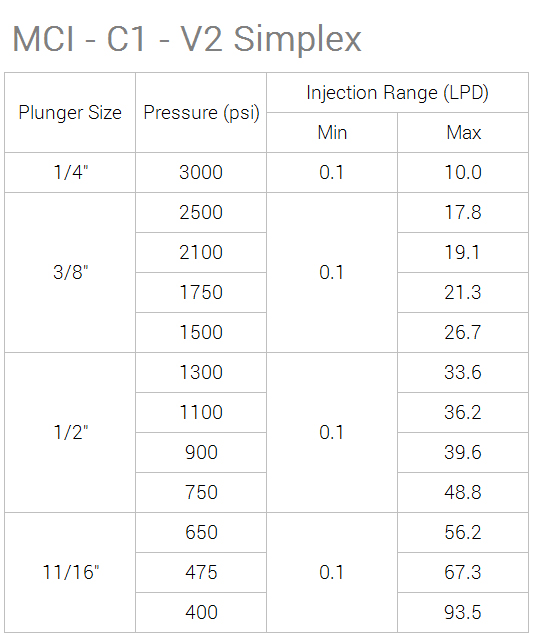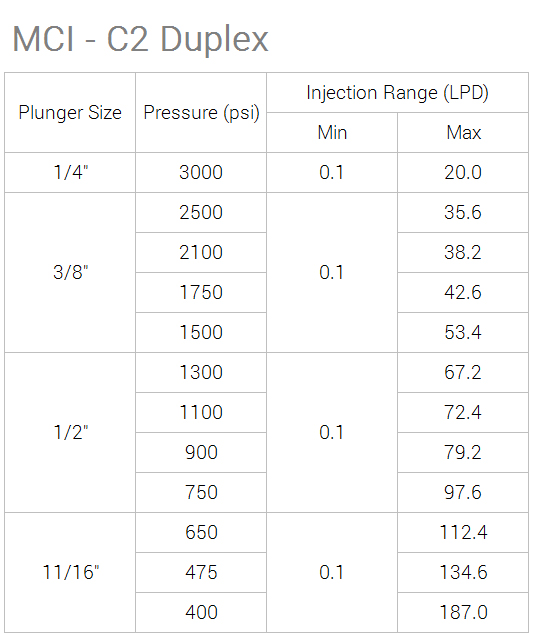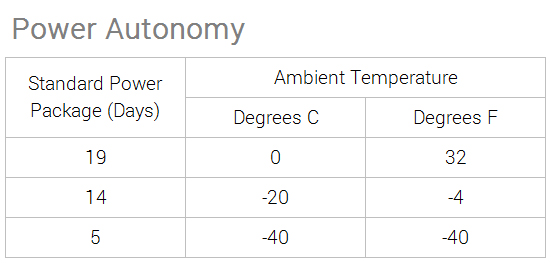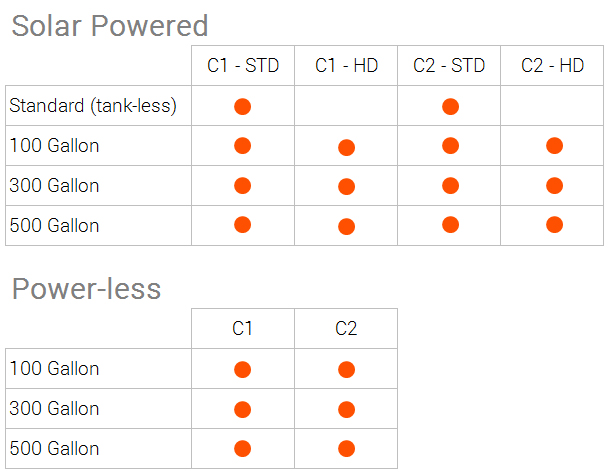Frequently Asked Questions
- Are MCI pumps CSA certified?
-
Are MCI pumps CSA certified?
MCI Pumps and Pump Packages are CSA certified for use in Class 1/ Division 2 environments. Optionally we manufacture a Class 1/ Zone (Division) 1 pump.
- What batteries do you use?
-
What batteries do you use?
We use four, or six, 12V, 120Ah absorbed glass mat (AGM) batteries. The batteries are wired in a series/ parallel configuration to create a 24V DC source for the drive controller.
- What kind of solar panel do you use?
-
What kind of solar panel do you use?
Our solar array includes two, or four, 160W (18.42V, 8.84A) CSA certified Class 1, Division 2 solar panels. They are wired in series for 24V DC required by our drive controller. For summertime operation the power system is extremely over sized. However the winter performance is the real test. We have designed our systems to operate without interruption on the coldest days with the least Peak Sunlight Hours, 1.5 hours per day. Please read the “Effect of Shade on Solar Panels” document.
- Does shade effect solar panel output?
-
Does shade effect solar panel output?
Yes. Many people in our industry are not fully aware of this issue. Please take a few minutes to read about the adverse effects of shade on solar powered equipment. Click here for a link to our New Articles section.
- What is the maximum operating range?
-
What is the maximum operating range?
Maximum injection pressures, 3,000 psi, and rate are dependent on plunger diameter. Below is the C1 pump output data. Double the output for the dual headed C2 pump. Both C1 and C2 pumps are Class I Zone 2 certified. If your HazLoc is Class I Zone 1 then learn more about the D1 pump.

- Does MCI build a Dual Headed pump?
-
Does MCI build a Dual Headed pump?
Yes. The C2 pump can provide twice the injection volume of the C1 pump or D1 pump, or it gives you the flexibility to inject independent volume and pressure into two separate points.

- Do you provide a low voltage cut-out?
-
Do you provide a low voltage cut-out?
Yes. MCI has an integrated low voltage cutout and automatic restart built into the drive controller. Using the GUI the cutout and restart voltage setting can be specified to protect the batteries from excessive discharge.
- What pump head do you use?
-
What pump head do you use?
MCI has developed our own fluid end. The FMT (Fluid Management Technology) incorporates the best of a displacement style head and suction/ discharge check valves. Refinements including precision machining, an integrated 1/8” NPT pressure transducer port and the built-in secondary containment technology have enhanced its capabilities. As always we DO NOT USE CONVENTIONAL V-PACKING. The secondary containment system was engineered into the FMT to eliminate packing and the associated leaking, gland nut tightening and plunger friction. Secondary containment reroutes any high pressure seal chemical bypass back to the suction side of the FMT.
- How do we know when to replace the seal kit?
-
How do we know when to replace the seal kit?
Seal kit wear varies greatly based on injection rate, pressure and chemical compatibility. During regular visual inspections production or maintenance staff can isolate the sight glass from the chemical storage tank and watch the liquid level position during the injection stroke. If the liquid falls and then rises in the site glass replace the suction check valve O-ring. If this circulation persists replace the seal kit. Alternatively plunger seal kit replacement can be included in your bi-annual preventative maintenance program.
- What seal material do you use?
-
What seal material do you use?
MCI pumps have three seal groups:
i) Fluid end check valve seals, suction and discharge, are perfluoroelastomer. A common trade name from perfluoroelastomer is Kalrez.
ii) Static face seals are Teflon.
iii) Dynamic plunger seals are UHMW Polyethylene.
- What plunger material do you use?
-
What plunger material do you use?
We have tested a number of options but selected Tungsten Carbide for its combination of material compatibility, wear resistance and cost effectiveness.
- What materials are used in the pump?
-
What materials are used in the pump?
We use carbon steel or, optionally 316 stainless steel, and tungsten carbide for all wet parts.
- Do you have Reverse Polarity check?
-
Do you have Reverse Polarity check?
Yes, the drive controller has Reverse Polarity Check. If the positive and negative wires are reversed the controller will not energize. Simply swap the power wires and the controller will start up without any damage to the system.
- How much power is consumed by your pump?
-
How much power is consumed by your pump?
Use the Efficiency Calculator in either the C1 pump, C2 pump 0r D1 pump product pages to determine the power consumption.
- Do you inject continuously?
-
Do you inject continuously?
Yes the C2 pump can inject chemical continuously. MCI manufactures pumps with three injection modes: continuous chemical injection, continuous injection cycle and Dwell.
- Is there a high efficiency mode?
-
Is there a high efficiency mode?
Yes. The MCI pump drive controller is easily programmable using the GUI. In continuous injection cycle mode (standard high efficiency) the MCI skid package power system can provide year-round reliable power. However in circumstances where the available power supply integrity is questionable or the skid location at site relative to the sun is less than optimal, the drive controller can be programmed for DWELL higher efficiency injection. This higher efficiency mode can reduce power consumption by up to 75%.
- How long will the batteries last?
-
How long will the batteries last?
Battery life and the associated pump run-times, without recharging the batteries, are completely dependent on the battery charge level prior to the “blackout”, the ambient temperature and the injection pressure and volume requirements. We estimate the following run-time with zero recharging during the blackout period:

- Can I use site power?
-
Can I use site power?
Yes. MCI pumps are available in both 12V (<1.0 amp) or 24V DC (<0.5 amp). Solar, wind, thermal electric generator (TEG) or other equipment can be used to power the MCI pump. If the site has 120V AC power you can use a rectifying power supply to produce 12V or 24V DC.
- Do I need an electrical junction box at the pump?
-
Do I need an electrical junction box at the pump?
No. The pump box has one 1/2” pre-punched hole for conduit/ wire entry. Within the pump box there is a terminal strip with screw terminals for all connections.
- Does MCI manufacture complete packages?
-
Does MCI manufacture complete packages?
Yes. MCI has a complete line of chemical injection skid systems including:

- Can the MCI pump be controlled remotely?
-
Can the MCI pump be controlled remotely?
Yes. The MCI v2 controller has a discrete input for ON/OFF control and an output for “pump state”. Optionally there is a communications key upgrade for full Modbus and 4-20mA analogue input control.
- Can we provide control feedback to the SCADA?
-
Can we provide control feedback to the SCADA?
Yes. MCI can provide the SCADA system with information from Modbus. Alternatively a 1/8” NPT port located in the fluid end will accommodate an pressure sensor (by other). This sensor can be monitored directly by the site control system. When no pressure transition signal is received the site control system can alarm for “tank empty”, “supply or discharge tube broken”, “pump seal bypass”, “PSV relief”, etcetera.
- Can the pump be controlled by temperature?
-
Can the pump be controlled by temperature?
Yes. The v2 controller comes standard with a thermister on a 10′ lead. Use the free GUI to set the automatic ON/OFF transition points.
